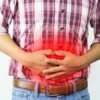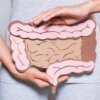
As a nutritionist in Manchester working with people who are dealing with a range of digestive issues, bloating is one of the most common symptoms I see in my clinic.
It’s not uncommon for this to happen alongside other digestive symptoms such as:
- Pain or cramping
- Constipation or diarrhoea
- Excess flatulence
- Heartburn or reflux
(Source: https://www.nhs.uk)
However, the bloating itself is often the most annoying and upsetting. It’s unpredictable, uncomfortable and can turn eating into a game of Russian roulette.
How do I stop bloating after eating bread?
If eating bread or wheat is a trigger for bloating, one option is to stop eating bread altogether.
If there is a reaction to a specific food, avoiding it can help in the short term to improve symptoms but it’s not addressing the underlying issue.
Additionally, bread and wheat products may be particularly enjoyable and hard to avoid during social events.
(Source: https://www.ncbi.nlm.nih.gov/)
Here are 4 tips to help support the gut and feel less bloated after eating
bread.
Step One: Support the Foundations
With any digestive symptom, such as bloating, supporting the foundations of good digestion is a good place to begin.
This sets up the digestive process and can help to reduce bloating.
The 3 key foundational aspects to focus on are:
Sleep
Poor sleep increases the sensitivity of the nerves within the gut lining and increases sensation of bloating. It can also negatively impact the balance and diversity of bacteria in the microbiome. Aim for 7-9 hours per night. (Source: https://www.aboutibs.org)
Chewing
There are only a few parts of the digestive process we have control over. One of those is how we chew our food. This helps to take a strain of the digestive processes and also stimulates the release of digestive enzymes further down the digestive tract.
Aim for 30 chews per mouthful. (Source: https://www.forbes.com)
Breathing and Relaxation Practices
Breathing and relaxation practices have been shown to improve overall gut health and improve symptoms such as bloating after eating bread or wheat. Interestingly, a study showed that a course of meditation and yoga was as beneficial as a low FODMAP diet. More of this diet below.
Aim for 10 minutes of breathing or meditation per day. (Source: https://pubmed.ncbi.nlm.nih.gov/)

Step Two: Manage your FODMAPs
FODMAPs are specific groups of carbohydrates found in a wide range of plant foods. These are considered healthy, however, if symptoms such as bloating or other symptoms of IBS are present, reducing the amount of FODMAPs consumed may help to improve overall symptoms. However, it does not address the underlying issue, instead it simply avoids potential triggers.
As mentioned, bread made from wheat contains fructans which is a FODMAPs that causes bloating in many people. Instead of following a full low FODMAP diet, some find it helpful to lower their overall FODMAP intake to reduce the overall load placed on the gut, while addressing the underlying issue.
The most common FODMAPs that can be an issue for people are;
- Wheat
- Garlic
- Onions
- Beans
- Lentils
(Source: https://www.webmd.com/ibs/guide/what-is-fodmap)
Step Three: Switch Bread
If the only FODMAP that seems to be an issue if wheat, sourdough bread may be a good option to switching to. Although this is a bread that still contain wheat is has a much lower fructan/FODMAP content and often causes less bloating after people eat it.
How is that possible?
Sourdough bread is made with fermented dough. This fermentation process is carried out by specific bacteria and yeasts that digestive the carbohydrates within the wheat. This can be thought of as these organisms predigesting that wheat, particularly the fructan component of it, before it even passes your lips.
This pre-digestion of the bread and wheat can take a big strain off the gut and may help with bloating.
(Source: https://www.ncbi.nlm.nih.gov/pmc/articles/PMC5848117/)
Step Four: Fix Your Gut
It can be tempting to simply work to avoid trigger foods indefinitely without addressing the reason what they might be causing bloating. Although, wheat and bread might be a trigger, the reason why are they causing bloating can often go overlooked.
Key supplements can be very helpful at reducing overall bloating from food. These include probiotic and prebiotics, both of which can help restore microbial balance in the digestive system.
To dive deeper then additional testing may be helpful. A SIBO breath test may be the best option if your bloating is happening very soon (within 1 hour) following a meal.
(Source: https://www.ncbi.nlm.nih.gov)
What causes your stomach to bloat and hurt after eating?
Bloating often begins after eating which may indicate that there is a specific food trigger. Or even a combination of triggers.
If you eat a meal the bloating may happen soon after you have eaten one of these trigger foods. There can also be delayed response with the bloating becoming noticeable up to 4 hours after you eat the specific food. (Source:https://www.healthline.com/)
When it comes to bloating after eating though, this delayed response can make identifying the food trigger difficult. This can also make working out the perfect restricted diet very challenging, and potentially even the wrong approach.
If food is causing a reaction it can be so important to remember it’s not the foods fault. In the vast majority of cases there is an imbalance somewhere in the digestive tract that is responsible for symptoms.
That being said, there is a lot that can be done. Even to help manage symptoms in the short term, such as avoiding or limiting specific foods which can make a big difference to bloating very quickly (Source: https://www.ncbi.nlm.nih.gov/).
Bloating can happen after eating with a wide range of food. This can often lead to someone attempting to try and identify and remove that specific food. Eliminating food after food can lead to a very restrictive diet. I’ve seen people in my clinic only eat 5 different foods and they’re still experiencing symptoms of bloating!
Bloating is rarely the foods fault. The reality is that the food may not be the issue but it’s the way your body is responding to it that is the problem.
Imbalances in the digestive system commonly lead to symptoms such as bloating with specific foods often triggering these symptoms.
In the majority of cases, the bloating is happening due to an imbalance is the fermentation process that happens in the gut. This imbalance leads to an inappropriate amount of gas being produced or a disruption in how that gas is processed by other bacteria.
This can be thought of as a gas production line with either overproduction or under disposal of the gas which results in symptoms. When the gut bacteria are out of balance, both of these can even happen at the same time.
This gas builds up leading to bloating. This can then put a considerable amount of pressure on the nerves that line the gut, resulting in the symptoms of increased pressure in the stomach and considerable pain.
Very often, these symptoms can happen soon after eating and can be extremely painful. (Source: https://www.ncbi.nlm.nih.gov)
Why does bread make me bloat?
Eating bread can cause bloating and other digestive symptoms in individuals with a wheat sensitivity. To alleviate these issues, try eliminating bread from your diet or opting for gluten-free alternatives. Many people find relief from digestive discomfort by avoiding wheat-based products like bread, pasta, and cereals.
It happens frequently for many people with digestive issues such as IBS but also in others who do not have this condition. It can still be the case that foods cause bloating even when someone does not have IBS.
The digestive system is a dynamic environment with a wide range of bacteria, digestive enzymes and food particles travelling through it on a daily basis. A common reason for bloating after eating bread, or other wheat containing food, is an imbalance in one of these areas.
In a happy and balanced gut where there are no symptoms of bloating digestive processes are balanced.
To understand this, we can divide the digestive system into 3 main sections, each with a unique role.
| Section 1 | The mouth and stomach | Mechanically breaking down the food into small particles and begins digestive processes |
| Section 2 | The small intestine | Absorption of nutrition |
| Section 3 | The large intestine | Fermentation and reabsorption of water |
While we want there to be fermentation taking place, we like this to be in the correct part of the digestive tract and in the correct balance. (Source: https://www.niddk.nih.gov/)
We see that specific components in bread, such as wheat, can be particularly triggering for bloating.
But why?
Wheat is high in a specific type of carbohydrate known as fructan which, when added to an imbalance digestive system can lead to bloating. The imbalance outlined above, either too much gas being produced, or not enough being broken down, can happen in 2 sections of the gut.
- The small intestine.
- The large intestine.
These can be identified in slightly different ways. In particular if the bloating is happening within 1 hour of eating if may be in the small intestine, while bloating gradually building up throughout the day more likely to be in the large intestine.
The main reason for the bloating to happen after eating bread or wheat, can be either one of these imbalances. As this is a bacterial imbalance, we commonly see an elevation of the bacteria that love to digest wheat, in particular the fructan component.
If we have too many of the bacteria that like to consume wheat, high levels of gas is produced during the fermentation process, and we end up bloating. (source: https://www.ncbi.nlm.nih.gov/)
What are the alternatives to bread?
If the only option for you is to remove bread 100% there are other alternatives.
- Try a wheat free bead. Option includes rice and quinoa.
- Instead of making a wrap made from wheat flour, try whisking 2 eggs and making an omelette. This can be used as a replacement for wraps. View the recipe here.
- Another option is to slice a sweet potato length ways into 1 cm slices that resemble a piece of bread. This can either be toasted in a toaster or under the grill and make a surprisingly good bread alternative. View the recipe here.
Conclusion
So, there we have it. I hope this has given you a few ideas to help navigate any bloating that might come with bread.






